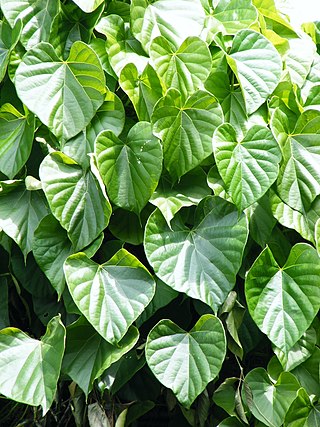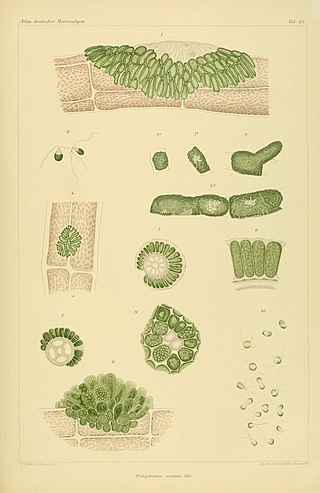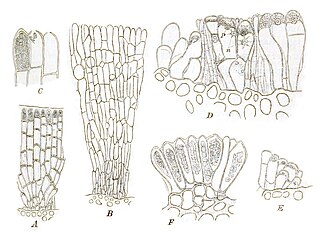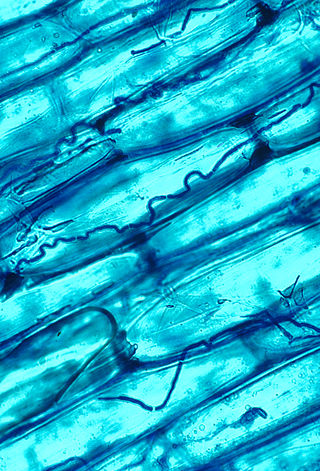
An endosymbiont or endobiont is any organism that lives within the body or cells of another organism most often, though not always, in a mutualistic relationship. (The term endosymbiosis is from the Greek: ἔνδον endon "within", σύν syn "together" and βίωσις biosis "living".) Examples are nitrogen-fixing bacteria, which live in the root nodules of legumes, single-cell algae inside reef-building corals and bacterial endosymbionts that provide essential nutrients to insects.

Lycopodiopsida is a class of vascular plants known as lycopods, lycophytes or other terms including the component lyco-. Members of the class are also called clubmosses, firmosses, spikemosses and quillworts. They have dichotomously branching stems bearing simple leaves called microphylls and reproduce by means of spores borne in sporangia on the sides of the stems at the bases of the leaves. Although living species are small, during the Carboniferous, extinct tree-like forms (Lepidodendrales) formed huge forests that dominated the landscape and contributed to coal deposits.

An endophyte is an endosymbiont, often a bacterium or fungus, that lives within a plant for at least part of its life cycle without causing apparent disease. Endophytes are ubiquitous and have been found in all species of plants studied to date; however, most of the endophyte/plant relationships are not well understood. Some endophytes may enhance host growth, nutrient acquisition and improve the plant's ability to tolerate abiotic stresses, such as drought and decrease biotic stresses by enhancing plant resistance to insects, pathogens and herbivores. Although endophytic bacteria and fungi are frequently studied, endophytic archaea are increasingly being considered for their role in plant growth promotion as part of the core microbiome of a plant.
Georgii Adamovich Nadson was a Soviet biologist, "one of the pioneers of radioecology in Russia" He became professor at St. Petersburg University in 1900. In 1930, he founded the Laboratory of Microbiology of the Russian Academy of Sciences. He was director of the institute until 1937, when he was "falsely accused of participating in so-called anti-Soviet sabotage and terrorism and arrested" On April 14, 1939, he was found guilty of participation in a terrorist organization, and on the next day he was shot and buried at the Kommunarka shooting ground. The real reason for his execution was his opposition to Lysenkoism.

Tinospora cordifolia is a herbaceous vine of the family Menispermaceae indigenous to tropical regions of the Indian subcontinent. It has been used in Ayurveda to treat various disorders, but there is no clinical evidence that it is effective.

Pavetta is a genus of flowering plants in the family Rubiaceae. It comprises about 360 species of trees, evergreen shrubs and sub-shrubs. It is found in woodlands, grasslands and thickets in sub-tropical and tropical Africa and Asia. The plants are cultivated for their simple but variable leaves, usually opposite but also occur in triple whorls. The leaves are often membranous with dark bacterial nodules. Pavetta has small, white, tubular flowers, sometimes salviform or funnel-shaped with 4 spreading petal lobes. The flowers are carried on terminal corymbs or cymes.

Ulvellaceae is a family of green algae in the order Ulvales.
Acrochaete is a genus of marine green algae of the family Ulvellaceae known to live as endoparasites of other algae, although they may eventually be found growing on inorganic substrates, such as rocks.

Pseudopringsheimia is a genus of green algae, in the family Ulvellaceae.

Snow Mountain garlic, is a subspecies of garlic which is found in the mountainous in Jammu and Kashmir. It grows well in the western Himalayas at altitudes of up to 1,800 m (6,000 ft), in temperatures as low as −10 °C (14 °F), and with very little oxygen. In Hindi, it is known as ek pothi lahsun.
Ulvella is a genus of fungi in the Ascomycota phylum. The relationship of this taxon to other taxa within the phylum is unknown, and it has not yet been placed with certainty into any class, order, or family. This is a monotypic genus, containing the single species Ulvella chlorospila.

Plant use of endophytic fungi in defense occurs when endophytic fungi, which live symbiotically with the majority of plants by entering their cells, are utilized as an indirect defense against herbivores. In exchange for carbohydrate energy resources, the fungus provides benefits to the plant which can include increased water or nutrient uptake and protection from phytophagous insects, birds or mammals. Once associated, the fungi alter nutrient content of the plant and enhance or begin production of secondary metabolites. The change in chemical composition acts to deter herbivory by insects, grazing by ungulates and/or oviposition by adult insects. Endophyte-mediated defense can also be effective against pathogens and non-herbivory damage.

Pestalotiopsis microspora is a species of endophytic fungus capable of breaking down and digesting polyurethane. Originally identified in 1880 in fallen foliage of common ivy in Buenos Aires, it also causes leaf spot in Hypericum 'Hidcote' shrubs in Japan.

Fumigaclavine A is an antibacterial ergoline alkaloid produced by endophytic Aspergillus.

Siderin is a bio-active coumarin derivative produced by Aspergillus versicolor, an endophytic fungus found in the green alga Halimeda opuntia in the Red Sea.

9-Deacetoxyfumigaclavine C is an ergoline alkaloid. It is a potent, selective, anticancer compound, with in vitro activity comparable to doxorubicin (IC50 = 3.1 μM against K562). 9-Deacetoxyfumigaclavine C is a compound made by a variety of fungi.

Myrcia guianensis (pedra-ume-caá) is a species of plant in the genus Myrcia of the family Myrtaceae native to South America.
Flindersiella endophytica is an endophytic bacterium from the genus Flindersiella which has been isolated from the tree Eucalyptus microcarpa in Adelaide in Australia.
Ulvella is the scientific name of two genera and may refer to:














